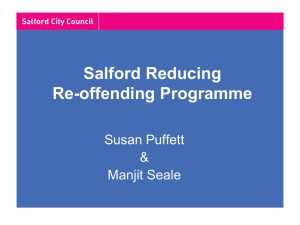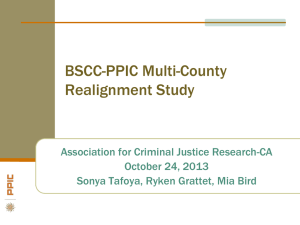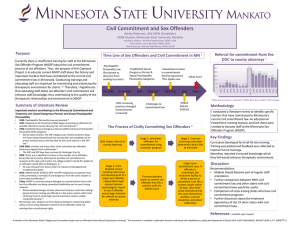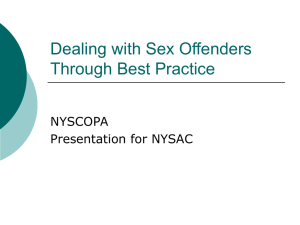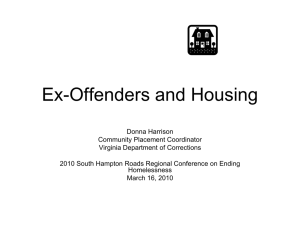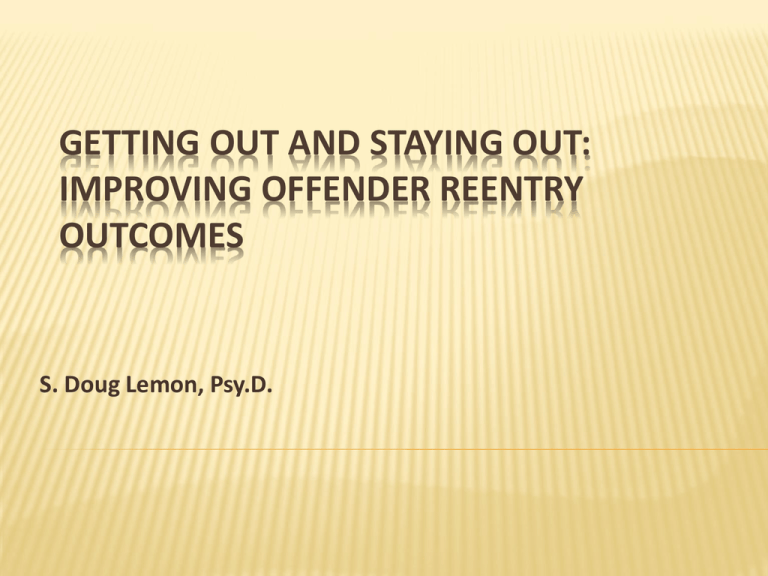
GETTING OUT AND STAYING OUT:
IMPROVING OFFENDER REENTRY
OUTCOMES
S. Doug Lemon, Psy.D.
The views expressed in this presentation do not
necessarily reflect the views of the U.S.
government, the U.S. Department of Justice, or
the Federal Bureau of Prisons.
OVERVIEW
WHY FOCUS ON REENTRY?
BENEFITS OF REENTRY PROGRAMMING
Save time and money
information sharing
collaboration
reduced duplication of effort
Reduce the likelihood that a released inmate will
commit a new crime
Reduced recidivism increases public safety
Addresses community issues such as homelessness,
addiction, public health, and mental illness
THE SCOPE OF THE PROBLEM
2 million people incarcerated in the U.S.
One out of every 100 Americans
1 of every 31 Americans is incarcerated, on
probation, or on parole
Source: The Pew Center
THE SCOPE OF THE PROBLEM
THE SCOPE OF THE PROBLEM
Local governments spent $109 million on
criminal justice in 2006 (U.S. Bureau of Justice Statistics)
States spend $52 billion annually, mostly on
prisons (The PEW Center)
2011 budget request for federal prisons,
probation, detention, and courthouse security
was $9 billion (U.S. Department of Justice)
THE SCOPE OF THE PROBLEM
600,000 released from prison each year (Hughes
and Wilson, 2003)
After 3 years, 43% return (The PEW center, 2011)
95% return to our communities.
REENTRY AND REDUCING RECIDIVISM
We need to be focusing on doing what works to
reduce recidivism and to prepare offenders for
a successful reentry into society.
THE CURRENT SITUATION
“ those who violate the law and victimize others
must be held accountable…for the long-term
protection of the community, sentencing and
corrections should be using the lessons of
research to shape practices that reduce
offenders’ likelihood of committing crimes and
victimizing their fellow citizens in the future…in
light of the harsh fiscal realities of the day, both
goals must be pursued through the wise use of
public resources.” (Nat’l Institute of Corrections)
WHAT RESEARCH TELLS US ABOUT OFFENDERS
68 percent abusing or dependent on alcohol or drugs
44 percent without high school diploma or GED
30 percent unemployed prior to arrest
16 percent suffer from serious mental health problems
44 percent homeless in year prior to arrest
72 percent of mentally ill inmates have a substance
abuse problem
(Bureau of Justice Statistics)
EXERCISE
THE OFFENDER’S WORLDVIEW
Cognitive Map
THE OFFENDER’S WORLDVIEW
Changing behavior won’t work
Changing attitude won’t work
Must change the map!
EXERCISE
FINISHED FILES ARE THE RESULT OF YEARS OF
SCIENTIFIC STUDY COMBINED WITH THE
EXPERIENCE OF MANY EXPERTS.
CHANGE IS THREATENING
Resistance
Denial
DENIAL
D on’t
E ven
N otice
I
Am
L ying
Feel
worthless
World is
Hostile
Becomes
Hostile
Hopeless
COMFORT ZONES
OUR WORLDVIEW
What do we really think about the offenders we
work with?
What do we believe about their ability to
change?
What do we believe about our ability to help
them change?
OUR WORLDVIEW
If we believe inmates are just a bunch of losers
who can’t change, are we really going to work
to reach out to them?
OUR TYPICAL INTERVENTIONS
We can only control our part of the equation
We stoke offender resistance with our negative
attitudes
Their comfort zone includes arguing about their
belief systems
EFFECTIVE COMMUNICATION WITH OFFENDERS
Listen
Show RESPECT
Firm, Fair, Consistent
Hold them accountable
Own what you teach
Crawl into their minds
Create environment where offender can be real
with you, and you with him/her
EFFECTIVE COMMUNICATION WITH OFFENDERS
In short, be more of an Andy Griffith than a
Barney Fife
EFFECTIVE COMMUNICATION WITH OFFENDERS
Offender isn’t challenged this way in his usual
social network.
You may be the only person challenging his/her
belief system in a nonthreatening way.
EFFECTIVE COMMUNICATION WITH OFFENDERS
Every man is my superior, in that I may learn from
him.
-Thomas Carlyle
EFFECTIVE COMMUNICATION WITH OFFENDERS
“I gave it my best”
WHAT WORKS?
Evidence-based practice
Best practices
WHAT WORKS
Principles of evidence-based correctional
practice:
Objectively assess criminogenic needs/risks
Enhance intrinsic motivation
Target higher-risk offenders
Address greatest criminogenic needs
Use cognitive-behavioral interventions
Determine dosage/intensity of services
WHAT WORKS
Target behaviors that reduce crime
Be responsive to the offender’s style
ASSESSMENT OF CRIMINOGENIC NEEDS
Instruments may include:
LSI-R
LS-RNR
LSCMI
COMPAS
Specialized instruments
LSI-R
Identifies problem areas
Predicts recidivism risk
54 items
Completed by trained assessors
Interview offenders
Attempt to verify information with records
CRIMINOGENIC RISK/NEEDS FACTORS
History of antisocial behavior/thinking
Antisocial associates/family
Lack of contact with prosocial others
Substance abuse
Weak socialization
Egocentric/lack of empathy
Impulsivity
Poor problem-solving and coping skills
CRIMINOGENIC RISK/NEEDS FACTORS
Lack of achievement in “legit” society
Not involved in prosocial leisure activities
WHAT WORKS
Amount of CBT intervention required:
High-risk offenders: 300+ hrs.
Moderate-risk:
200+ hrs.
Low-risk:
100 hrs.
WHAT WORKS
During the first few months post-release:
40-70% of offenders’ time should be structured
(Bourgon and Armstrong, 2006; Latessa, 2004; Gendreau and Goggin, 1995)
PROGRAMS THAT WORK
(LATESSA, UNIVERSITY OF CINCINNATI)
Are based on research & sound theory
Have leadership
Assess offenders using risk &need assessment instruments
Target crime producing behaviors
Use effective treatment models
Vary treatment & services based on risk, needs, &
responsivity factors
Disrupt criminal networks
Have qualified, experienced, dedicated & educated staff
Provide aftercare
Evaluate what they do
Are stable & have sufficient resources &support
WHAT WORKS
A recent meta-analysis found:
CBT reduced recidivism by 25%
Some programs reduced it by 50%
WHAT WORKS
Best results :
2+ sessions/week
Staff trained in CBT
Implementation monitored
Higher risk offenders
CBT combined with other services
*Landenberger, N, and M. Lispey (2005). The Positive Effects of Cognitive Behavioral Programs
for Offenders: A Meta Analysis of Factors Associated with Effective Treatment. Journal of
Experimental Criminology.
WHAT WORKS? REACH IN-REACH OUT
Community involvement
Assist with training offenders
Serve as mentors
Invite successful ex-felons to speak/serve as
mentors/role models/AA or NA sponsors
Conduct a job fair for newly released offenders
Identify community service opportunities to
assist with establishing real work experience
WHAT WORKS?
Community involvement:
Establish a clothes closet
Organize a Health Fair, Dress for Success Fair
Provide tutoring
Sponsor one newly released offender for a year
Organize transportation to critical
appointments
Write letters to or visit inmates
DRUG ABUSE TREATMENT
Residential
Inmates live in a program unit
Incentives such as money or reduced sentence
Employ therapeutic community model
Treatment continues in the community
DRUG COURTS
Divert nonviolent substance abusers from
prison/jail to treatment
Usually last 18 months
Involve a team approach
Team meets with offender biweekly for first
several months
Random UA’s at least twice/week for first
several months
DRUG COURTS
Provide progressive sanctions and contingent
rewards
Involve expedited case processing
Reduce recidivism by 8-26%
Can greatly reduce juvenile substance abuse
COMMUNITY SUPERVISION SERVICES
Case plans stem from risk/need assessments
Use graduated responses
Structured, swift, incremental responses
Staff receive training in effective offender
management techniques
Focus on improving relationship between PO
and offender
Bonta, et al, (2010) The Strategic
Training Initiative in Community
Supervision: Risk-Need-Responsivity in
the Real World. Public Safety Canada.
2-YEAR RECIDIVISM RESULTS-CANADIAN STUDY
WHAT DOESN’T WORK
(LATESSA, UNIVERSITY OF CINCINNATI)
Drug prevention focused on fear/emotional appeals
Shaming
Drug education
Non-directive approaches
Bibliotherapy
Psychoanalytic approaches
Self-Help programs
Vague unstructured rehabilitation programs
Medical model
Improving self-esteem
“Punishing smarter” (boot camps, scared straight, etc.)
WHAT DOESN’T WORK
Providing high-intensity services to low-risk
offenders increases their risk of recidivism
More contact with high-risk offenders
Disrupts their prosocial networks
EXERCISE
THIS LITTLE CARD IS JUST AN EYE-CATCHER
ALWAYS IS THERE THAT REALIZE YOU HELP TO
ANOTHER WAY TO DO ALMOST ANYTHING,
IS IT TIME FIRST THE. READING INCLUDING
ALWAYS HARD TO DO SOMETHING A NEW WAY
HAVE YOU THAT NOW AGAIN THIS READ BUT
THE HANG OF IT! GETS EASIER DOESN’T IT?
HOW NOT TO COMMUNICATE WITH OFFENDERS
Some adopt an abrasive style to make it clear
they won’t be taken advantage of.
Who are they trying to convince?
HOW NOT TO COMMUNICATE WITH OFFENDERS
Some believe confrontation is the only thing
offenders understand.
HOW NOT TO COMMUNICATE WITH OFFENDERS
Some believe offenders need to know how
serious their offenses are, thus justifying
disrespect on the part of the officer.
MOTIVATIONAL INTERVIEWING
Goal: To increase client’s intrinsic motivation to
change through the exploration and resolution
of ambivalence.
Goal: Strengthen commitment to change.
MOTIVATIONAL INTERVIEWING
Four Parts:
Expressing empathy
Developing discrepancy
Rolling with resistance
Supporting self-efficacy
MOTIVATIONAL INTERVIEWING
Motivational Interviewing (MI) is well-researched.
Scores of studies with substance abuse and
health problems
A few with offenders:
Harper & Hardy, 2000
Clark et al, 2006
Walters et al, 2007
Scott, 2008
McMurran, 2009
MOTIVATIONAL INTERVIEWING
Assess offender’s readiness for change.
Readiness is not all-or-none
Where is he/she on the continuum?
MOTIVATIONAL INTERVIEWING
“If you decided to do this, how could it make
things better for you?”
MOTIVATIONAL INTERVIEWING
For more details, see :
Motivating Offenders to Change, NIC (2007)
DURING INCARCERATION
DURING INCARCERATION
The time doesn’t change people
It can have a motivating effect, though
Incentives increase program participation
DURING INCARCERATION
Inside Out, a SMART Recovery program
Thinking for a Change (FREE!)
Residential drug programs
Residential change programs
DURING INCARCERATION
Community involvement is key
DURING INCARCERATION
Job Fairs
Reach Out to community
Precede by courses in resume writing, job
interviewing, mock interviews
Involve probation
List of companies who hire former inmates
DURING INCARCERATION
Can gain work experience
Apprenticeship programs
College courses
Computer skills
THE FRANKLIN REALITY MODEL
-HYRUM SMITH, FRANKLIN COVEY
THE REALITY MODEL
Will the results of my behavior meet my needs
over time?
THE REALITY MODEL
Seven Natural Laws
1.
2.
3.
4.
5.
6.
7.
If the results of your behavior do not meet your needs, there is an
incorrect belief on your belief window.
If your self-worth is dependent on anything external, you are in big
trouble.
Results take time to measure.
When the results of your behavior do meet your needs over time,
you experience inner peace.
Growth is the process of changing beliefs on your belief window.
The mind naturally seeks harmony when presented with two
opposing beliefs.
Addiction is the result of deep and unmet needs.
THE REALITY MODEL
There are “Six Steps to Follow” in the Franklin Reality
Model:
1.
2.
3.
4.
5.
6.
Identify the behavior pattern.
Identify alternative beliefs.
Identify possible beliefs driving the behavior.
Predict future behavior based on the new beliefs
(principles).
Predict future behavior based on those beliefs.
Compare steps 3 and 5.
COMMUNITY SUPERVISION
COMMUNITY SUPERVISION
Much less expensive and more effective.
0.4
0.35
0.35
0.3
0.25
0.2
0.15
0.17
0.1
0.05
0
Community Based
Institutional
COMMUNITY BASED VERSUS INSTITUTIONAL
PROGRAMS: RESULTS FROM META-ANALYSES
Source: Gendreau, P., French, S.A., and A. Taylor (2002). What Works (What Doesn’t Work)
Revised 2002.
COMMUNITY SUPERVISION
“Swift and Certain” consequences
Immediate
Brief
Certain
Graduated, progressive consequences
COMMUNITY SUPERVISION
Encourage employers to use the Work
Opportunity Tax Credit.
Tax credit for employers
New hire must be felon convicted by federal or
any state court.
New hire must be within a year of conviction or
release.
Targets low-income new hires
COMMUNITY SUPERVISION
Encourage employers to utilize the Federal
Bonding Program
Indemnifies employers for lost money or
property due to dishonest acts of employees
Free of charge
No deductible
1% of bonds issued ever resulted in a claim
COMMUNITY SUPERVISION
“I wasn’t realizing that my goal was to keep
people out of prison, not to make sure that they
were model citizens.”
COMMUNITY SUPERVISION
Quality steady employment is a strong protective
factor (Shover 1996; Sampson and Laub 1993; Uggen 2000)
Barriers to Employment:
Unemployment rate 10%+
Rate for blacks is 19% (Economic Policy Institute, 2011)
COMMUNITY SUPERVISION
2003 Study by Deva Pager of Northwestern U.
Criminal record decreases chance of callback
by 50%
Race itself was a significant factor (34 vs.14)
Criminal record was a stronger negative factor
for blacks (17 vs. 5)
COMMUNITY SUPERVISION
35
30
25
20
with
without
15
10
without
5
0
with
Whites
Blacks
SEX OFFENDERS
93% of child sexual abuse victims knew their
perpetrator (35% perps are family members)
64% adult female victims knew their perpetrator
intimately
Represent 10-30% of prison population
10-20 thousand are released annually
5% arrested for another sex crime in 3 years
Recidivism rate lower than rate for all offenders
combined
SEX OFFENDERS
Face a number of barriers:
Public stigma
S.O.-specific laws
Problems with housing
Problems with employment
Often serve longer sentences
SEX OFFENDERS
Assessment Instruments:
RRASOR
STATIC-99
SORAG
MnSOST-R
VASOR
ABEL
Visual Reaction Time (VRT)-newly approved
plethysmograph
SEX OFFENDERS
Demand exceeds capacity in prison treatment
programs
Are not all the same
It is our duty to protect them from abuse
PREA
SEX OFFENDERS IN PRISON
High-risk offenders get first priority
Tailor programs to level of risk
Offer treatment closer to release
All staff should be trained
Should be subject to enhanced monitoring and
restricting access to provocative materials
Discretionary release dates provide incentive to
program
SEX OFFENDERS ON SUPERVISION
Link releasing offenders with treatment
providers for continuity of care
Continue assessments begun in prison
Develop and train community volunteers for
community support
Determine if there is a need for family therapy
Anticipate likely housing/employment problems
MENTALLY ILL OFFENDERS
Intake screening is vitally important
Medical/psychiatric involvement crucial
Track med compliance and communicate
Staff should be trained
Have clear suicide prevention policies
Ensure prison mental health staff have
autonomy with suicidal offenders
Not enough hospital beds for those in need
MENTALLY ILL OFFENDERS
Coping skills training
Co-occurring disorders
See mentally ill in chronic care clinics
Utilize advanced students when possible
Decisions about CCC/RRC, parole, camp status
MENTALLY ILL OFFENDERS
Ongoing collaboration with probation a must
Look for specialized CCC
Ensure continuity of community-based MH tx
More frequent meetings with P.O.
YOUNG OFFENDERS
Focus on education
Family is a huge part of the equation
Substance abuse
High degree of victimization
YOUNG OFFENDERS
Youth versions of commonly used risk
assessment tools have been shown to predict
criminal behavior.
(Olver, 2009)
YOUNG OFFENDERS
Suggested programs:
Seeds of Success
On Solid Ground
Thinking for a Change
DBT
Cage Your Rage (youth version)
YOUNG OFFENDERS
Connecticut DOC-Manson Youth Institution
Youth approved for early release were targeted
by peers
Started 4-6 week re-entry unit
Incidents sabotaging youth early release are
almost non-existent now
Community partners assist with seminars
Pre-scheduled services for releasing youth
REENTRY RESOURCES
Second Chance Act
National Reentry Resource Center
(nationalreentryresourcecenter.org)
TJC project website (jailtransition.com)
Life After Lockup: Improving Reentry from Jail to the
Community
The Jail Administrator’s Toolkit for Reentry
TJC Implementation Toolkit (web-based,
jailtransition.com/Toolkit)
REENTRY RESOURCES
Jail Reentry Roundtable
(urban.org/projects/reentryroundtable/roundta
ble9.cfm)
The National GAINS Center
(gainscenter.samhsa.gov)
Community Oriented Correctional Health Services
(cochs.org)
Alabama CPR Network (alabamacprnetwork.com)
REENTRY RESOURCES
U.S. Dept. of Justice (crimesolutions.gov)
Federal Bonding Program (bonds4jobs.com)
Work Opportunity Tax Credit (doleta.gov/wotc)
National Institute of Corrections (nicic.gov)
National Institute of Justice (nij.gov)
Harvard University Government Innovator’s Network
(innovations.harvard.edu)
National HIRE Network (hirenetwork.org)
Office of Justice Programs (ojp.usdoj.gov/reentry)




